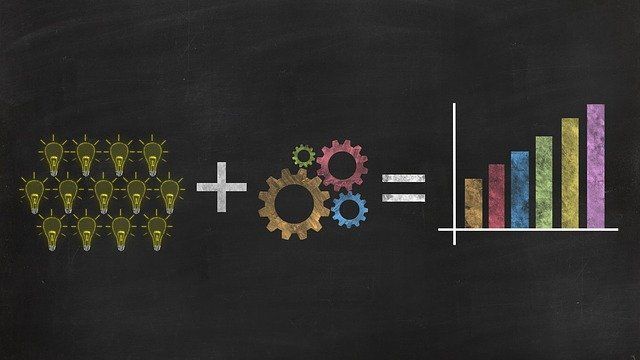Google AI Plans for 2030
When someone searches a query on Google, it leaves a carbon dioxide footprint in the atmosphere. Google AI plans for 2030 have been revealed, discussing what goals Google has to lower its carbon footprint and allowing other partners to play their part in guaranteeing environmental sustainability.

Google, a multi-billion-dollar tech giant that started its journey in 1998 is now considered a pillar of development. In this digital era, there would be hardly any person who is not familiar with Google and its search engines revolutionizing the internet. Google realized the importance of AI several years ago and now there are a plethora of Google services where AI is playing a vital role in bringing improvements. According to Google's co-founder Larry Page, Google is not just about creating a search engine, rather it's about making AI.
Google and AI Growing side by side
Google, a multifaceted company deals extensively with software and hardware in multiple domains and clearly understands the significance of AI-powered products. The mission of Google is to consolidate global information and make it accessible to everyone. Google commits that AI is helping it to accomplish this mission in exciting ways. In our routine lives, AI-driven products of Google are assisting us in multiple ways making our tasks easier like searching a photo, finding timings of our favorite restaurants, finding locations, etc. Every time you put your query in the Google search bar, AI algorithms are working behind to generate answers to your queries. AI behind search engines understands our queries and delivers customized results. Based on the ease AI is delivering to users, Google will pursue using AI to surprise humanity. Google claims openly that all of its developments like its search engines, Google Maps, Google Assistant, and many more would have been impossible if the company had not invested its money, time, and efforts into emerging technologies like AI. But what is next for us? What is stored in the outstanding minds at Google for us in the coming 5 to 10 years? Well, recently Google has announced its plans for 2030. In this article, we will cover what is Google's plan for 2030 and how it relies on AI to carry out that plan?

Carbon Footprint of Google
Google and AI together are undoubtedly making our lives comfortable but the bitter truth is that the ease they are delivering us is not without a huge cost that we have to pay in the form of a polluted environment. Google searches have a huge negative impact on our environment by emitting carbon dioxide.
In 2009, Google reported that whenever a person searches a query on Google, it leaves its carbon footprint in the environment. According to Google, a single search of a query results in the emission of 0.2 grams of carbon dioxide in surroundings. However, some environmental consultants claim that the emission of CO2 per query ranges between 1g to 10g based on your device and the time you take to go through the results. Another research reveals that two typical Google searches results in the emission of 7g CO2 in the environment. All these facts demonstrate that Google's algorithms have a huge negative impact on the surroundings because of the huge amount of energy consumed in global data centers.
Research by Harvard University published in "The Sunday Times" reveals that the amount of CO2 emission while browsing two Google searches is the same as that of boiling water on the stovetop. Even just browsing a website emits 0.002g of CO2 per second. If the websites having complex videos are opened, they can emit even more CO2 i.e., 0.2g per second.
Google's Environmentally Conscious Initiatives
Google has been never happy with its publicity as harming the environment as a result of its carbon emissions. As soon as Harvard University published its research, Google posted an article on its official blog in which it negated the research and described how energy and environmentally conscious it has been as its data centers are the most energy-efficient in the world. According to Google, a car when driven to 1 km (0.6 miles) emits the same quantity of CO2 as emitted by browsing thousands of searches.
Google claims that not just the senior management, but Google employees are also very conscious about the environment. In 2019, two thousand Google employees appealed to the company to avoid selling its cloud computing tools and data storage to oil companies and stop funding politicians and boycott those who are not environmentally conscious.
Let's have a look at what initiatives Google has taken so far and what are its plans not just to reduce its carbon footprint but to enable other partners to play their role as well in ensuring environmental sustainability.
In 2007 – Google became Carbon-Neutral
In 2007, Google emerged as the first tech giant that became carbon-neutral. Being carbon neutral means that it balances the carbon emissions generated from fossil fuel burning by funding the projects of renewable energy that help in reducing carbon dioxide from the atmosphere. Google claimed that it has become carbon-neutral by planting trees, buying carbon offsets, and investing huge amounts in wind power in locations where it is plentiful to compensate for its tapping of natural gas power and coal in some other areas. It had been estimated that Google emitted one million metric tons of carbon dioxide in the environment since it was launched in 1998 till 2006. In 2007, Google announced that it has balanced that huge amount of CO2 and now Google has become carbon-neutral.
However, just depending on carbon offsets is not enough as Google emitted greenhouse gases in the atmosphere up to 4.9 million metric tons in 2018. This amount is more than the amount of CO2 emitted if 1 million vehicles are put out in a year.
In 2017 – Google became 100% dependent on Renewable Energy Sources
Since 2017, Google has reduced its carbon-based electricity consumption up to 100% and is relying on renewable energy sources. Google is now purchasing renewable energy to replace carbon-based electricity.

By 2030 – Google plans to become Carbon-Free
In September 2021, the CEO of Alphabet Inc., Sundar Pichai declared Google's AI plan to implement carbon-free operations in its data centers. Hence, Google aims to become the first tech giant that would be operating carbon-free by 2030. It means that every email created in Gmail and every query typed in Google search will be 100% carbon-free. Google has pledged that by 2030, its all data centers and all offices will be utilizing just clean energy that would not be carbon-based, and to achieve this goal it relies heavily on AI. According to an estimate of BCG's research, by 2030, AI would reduce the emissions of greenhouse gases by 5-10% worldwide. Google has planned to bring renewable energy of 5 gigawatts near some suppliers and it will also fund them for tree planting far more than its offset demand and will share its data or build a partnership with almost 500 governments worldwide so that 1 gigaton of CO2 is reduced on annual basis by 2030. Apart from balancing carbon emission through electricity consumption, Google also aims to offset CO2emission from employee travel. Furthermore, Google has planned to use various alternatives that would reduce carbon footprints. As Mr. Pichai said:
"We'll do things like pairing wind and solar power sources together and increase our use of battery storage".
He further added:
"And we are working on ways to apply AI to optimize our electricity demand and forecasting."
Google's AI-based strategy to Become Carbon-Free by 2030
To achieve its goal of becoming carbon-free by 2030, the basic roadmap for Google is using the most advanced technology AI. Let's have a look at how AI can help Google in achieving this goal!
AI to Optimize Cooling System of Data Centers
In 2016, Google along with DeepMind took the initiative to use ML in global data centers. The purpose of this initiative was to optimize the cooling system of global data centers. According to a research, DeepMind AI reduces the cooling bill of Google data centers by 40%. Now Google has developed a platform of "Industrial Adaptive Controls" with DeepMind that provides commercial and industrial facilities with AI-controlled cooling systems. The objective of this platform is to provide AI-powered energy savings worldwide. Google plans to ensure the availability of these solutions at an industrial level as well as to the software providers of building management who contribute almost 60% of commercial building footprint worldwide. This is the planetary scale efficiency. Hence, by cooling down the global data centers, AI is helping Google in reducing its carbon footprint.
AI to Shift Workload of Data Centers to Available Source of Renewable Energy
To become carbon-free, Google plans to shift the workload of a data center automatically to the other available renewable source of energy. To achieve this task Google has planned to employ an AI-powered “Carbon-Intelligent Computing” system that is AI-based. Let's have a brief look at this platform.
Carbon-Intelligent Computing Platform
This system will employ AI to automatically maximize the use of renewable energy across Google data centers that will ultimately reduce carbon impact and operational costs. This system works intelligently and automatically delays those workloads that are not urgent and time-sensitive for example encoding and image processing uploaded to Google Drive and Photos, or analyzing video uploaded on YouTube. According to the tech giant" Google", such tasks that are not so urgent and are flexible will just get delayed but still complete within 24 hours, whereas the user-facing services like Search, Maps, etc., and the production-related tasks that are critical will run around the clock and this AI-based system will not bring any delay in those tasks.

Data centers utilize 1% of global electricity and this percentage is now growing. Google aims to leverage ML to automatically reduce the carbon emission of a fleet of computers in data centers while considering the carbon intensity of energy sources and anticipated availability of these power sources to shift the time-flexible workloads to those hours when "green energy" is available.
Carbon intensity varies and depends on the energy source. For example, wind power is less carbon-intensive than coal, as producing one unit of electricity emits a lesser amount of carbon dioxide in the atmosphere. When the energy supply mix of the grid is carbon-intensive, then VCCs reduce hourly capacity and postpone the execution of flexible workloads to "green" times. According to the researchers, this system helps in reducing power consumption by 1-2% at times when carbon intensity is the highest. Though the reduction seems minor but considering the gigantic scale of Google's operations worldwide, it is a gigantic leap with enormous implications for tech giants to take notice of it and join in.
Furthermore, this system uses the tools of "risk-aware optimization" to fix Virtual Capacity Curves, or resource usage limits for the cluster operating system of each datacenter, that is responsible to allocate the task. The team of this system claims that the Carbon Intelligent Computing System of Google employs a demand forecast of a comprehensive cluster-specific resource. It also uses power models that are trained independently for each cluster. Hence, at the Google scale, this new system determines workload diversity and hardware configurations. Thus reducing the heavy workload on data centers, the AI system helps in reducing carbon footprints.
AI-based Forecasting Models for Job-scheduling
In data centers, workloads are hard to predict as you don't know before the time that what computing jobs will be running the next day. Hence, at the computing job level, there is high uncertainty. AI technology is very helpful in forecasting Google's flexible resource usage, along with daily consumption. This forecasting helps in job scheduling that eventually leads to reduced carbon footprints, global cost, and resource usage optimization for the future. Google employs AI-based prediction models to collect the forecast of carbon intensity for the next day and determines the energy demand based on historical data.

Eco-friendly Route Suggestions by Google Maps
Google is not just planning to reduce the carbon footprints of its own data centers and its applications but is also motivated to reduce overall carbon emissions in the environment. For instance, Google is striving hard to bring more than 100 AI-based developments to Google Maps so that its users get the most updated and correct route suggestions around the globe. These AI-powered advanced Google maps will be providing us default suggestions about the routes that would be the most eco-friendly with the minimum carbon footprint. For instance, Google Maps will be suggesting us the optimized route with less traffic congestion and fewer elevated roads to reduce the fuel consumption of the vehicle that would ultimately reduce carbon emission in the atmosphere. These eco-friendly routes will be having the same ETA (Estimated Time of Arrival) as that of the fastest route. If Google Map finds that the ETA of an eco-friendly suggested route is much higher than the fastest route, it will share with us the CO2 impact of both routes to compare and then will leave it up to us to decide which way to go.
Google – The World Brain
Besides becoming carbon-free, another goal of Google is to develop the "World Brain" by 2030 that would be facilitating every human being, every time and everywhere. As Google claims that it cares about every person on the planet, its "World Brain" is aimed to be taking care of all of us.
Other Environmentally Conscious Tech Giants
Apart from Google, several other tech giants are also planning to reduce or even diminish their carbon footprints. Some of these giants include:
Microsoft: In Jan 2021, it announced its aim to become carbon-free by 2030.
Apple: In July 2021, it announced its plan to make its entire business and supply chain free from carbon by 2030.
Amazon: Amazon has the goal to become carbon neutral by 2040.
The goal of these and many other tech giants to become carbon-free relies definitely on AI as it is the most advanced technology that can help reduce carbon footprints.
Decarbonized Future
Among other tech giants, Google is leading with generating carbon-free energy and making its operations carbon-zero with the help of AI and some other technologies. To accomplish its goal of becoming carbon-free, the Alphabet-owned giant has also planned to grant access to its AI power-saving software to other organizations. Furthermore, Google wants other companies to have a partnership with cities that want to develop sustainability projects.
Moreover, Google is working with governments, policymakers, and utilities to get these technologies implemented and bring changes at the system level to ensure that an entirely decarbonized future is attainable for everyone. According to Mr. Pichai, this decarbonized future will open more job opportunities as utilizing just carbon-free energy would result in creating 12,000 jobs within the next five years.
Summary
It would be wrong to deny the negative impact of Google on the environment. To run its data centers worldwide, Google has to utilize enormous energy that leaves its carbon footprints. At the same time, negating Google's seamless efforts to minimize its carbon footprints would also be unjust. Google was the first company to achieve carbon neutrality in 2007. It was also among the largest corporate buyers that were utilizing renewable energy. Now to achieve its new goal of becoming carbon-free by 2030, it is extensively relying on AI. It has intended that by employing AI, it will modify its whole processes carried out at its data centers and renewable energy in such a way that will result in the elimination of greenhouse gas emissions by 2030. As soon as Google's data centers are completely run by carbon-fee energy, our every activity on Google whether it's about sending an email through Gmail, searching a query on Google, or using Google map will be operated using clean energy every time of the day. Google also aims to bring countless improvements in its AI-based applications like "Google Maps" by suggesting eco-friendly routes that would lead to lesser fuel consumption and eventually lesser carbon emissions. Moreover, Google has planned to enable other companies to implement sustainable operations. If Google follows the same track of getting environmental sustainability with the same enthusiasm, it is much likely that we will observe giant leaps of Google in multiple domains in the coming years. As Mr. Sundar Pichai stated:
"Not long ago it was hard to imagine 24/7 carbon-free electricity supply – at a simple level, the wind does not always blow and the sun does not shine at night, but thanks to trends in Technology, and with the right government policies, the promise of 24/7 clean energy will soon be within reach."



